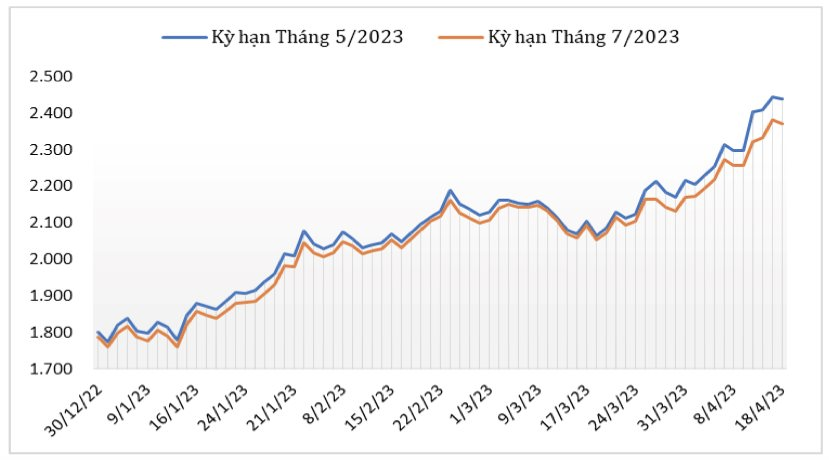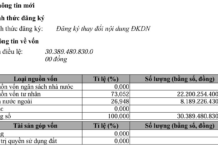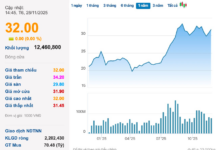The rice giant of An Giang, Loc Troi, had high hopes for its shift in focus towards its rice business, aiming to capitalize on the export opportunities in 2022-2023. However, poor cash flow management, high debt, and advancing money to farmers for production have led to a less-than-stellar financial situation for the company.
In 2023, while rice exports drove revenue to a record high of VND 11,233 billion, Loc Troi’s gross profit stood at a mere VND 253 billion. This translates to a meager 2% gross profit margin for the group, even lower than the previous year’s 2.9%.
At the annual general meeting in 2023, Loc Troi acknowledged the thin profit margins in the rice industry. The company has to advance money to farmers for rice procurement, production, and exports, offering zero-interest loans for these purposes. Meanwhile, Loc Troi has had to borrow from banks during a challenging period in the capital market, facing high-interest rates that eat into their profits.
Increasing rice exports, diminishing profits
Loc Troi is not alone in this predicament. Several large enterprises in the rice industry closed out 2023 with disappointing results. Despite higher revenues driven by strong exports, profits were meager, and gross margins for most players declined significantly.
According to data from the Ministry of Agriculture and Rural Development, Vietnam exported approximately 8.29 million tons of rice in 2023, earning USD 4.78 billion. This represented a 16.7% increase in volume and a 38.4% surge in value compared to 2022. These figures marked a record high in Vietnam’s over 30 years of rice exports.
2023 also witnessed an increase in the number of countries importing Vietnamese rice. The high international demand pushed Vietnam’s average export price to new heights, peaking at USD 663 per ton in early December 2023 and surpassing competitors to become the world’s highest.
However, as revenues rose, profits dwindled due to high borrowing costs and pressure from farmer purchases. Vietnam Plant Protection Joint Stock Company (NSC) maintained a relatively high gross profit margin of 31%, but even this figure represented a nearly 4% decline.
Some major players reported losses. For instance, Trung An High-tech Agriculture Joint Stock Company (TAR) achieved a revenue of VND 4,484 billion, an 18% increase, but incurred an after-tax loss of over VND 19 billion. In contrast, the company had recorded a profit of VND 75 billion in 2022. TAR’s gross profit margin also narrowed from 4.2% to 2.9%…
Cement companies struggle despite public investment wave
Poor inventory management and cash flow issues have also impacted the cement industry, with most companies facing challenges in 2023 despite the expected benefits from public investment.
Recently, HNX announced a list of unprofitable cement companies ineligible for margin trading, including prominent names such as Bim Son Cement Joint Stock Company (BCC, with a net loss of over VND 227 billion), Vicem But Son (BTS, net loss of over VND 96 billion), Hai Phong Cement (HCT, first loss in many years), and Vicem Hoang Mai (HOM, unexpected loss of over VND 31 billion after years of profitability)…
While public investment was anticipated to boost the economy and related industries like cement, the impact was not immediate due to delays in capital disbursement. Vicem Hoang Mai, for instance, has won consecutive bids to supply cement to the Nghe An Department of Finance for rural development projects, but most of the revenue remains in accounts receivable, awaiting payment.
Leaders of some companies involved in public investment projects acknowledge that this sector provides stable revenue for operations and salary payments but typically offers low-profit margins.
At the annual general meeting earlier this year, Mr. Dao Ngoc Thanh, Chairman of the Board of Vinaconex, mentioned that fluctuations in material prices, rising labor costs, and prolonged settlement and payment processes result in low-profit margins for public investment projects.
Mid-year, Mr. Ha Quang Hien, Chief of Office of Vietnam National Cement Corporation (Vicem), also shared that the company’s production and consumption targets (both domestic and export) had not been met, despite various measures taken to boost sales.
Overall, the long-term and sustainable momentum for the cement industry depends on the recovery of the real estate sector and the export market for clinker.
Coffee prices soar to world’s highest, yet companies face record losses
A similar paradox is playing out in the coffee industry.
In the first quarter of 2024, coffee prices surged due to concerns over supply shortages. While the price ranged from VND 59,000-60,000/kg in November 2023, it climbed to VND 62,000-69,000/kg in December. By January 2024, it had reached VND 82,000/kg, and by early March, it stood at VND 86,000/kg. Currently, it has soared to VND 94,500/kg.
Consequently, the price of Vietnamese Robusta coffee has reached the highest level globally, surpassing even India. One would assume that Vietnamese coffee traders are reaping significant benefits from this price surge. However, according to industry insiders, while the demand for coffee bean purchases has increased, the supply remains limited. Farmers are hoarding their beans due to high prices, leaving traders with insufficient stock to meet their export commitments. As a result, companies are buying high and selling low, incurring losses.

Vietnamese coffee prices soared to the world’s highest in early 2024.
This situation has put Vietnamese coffee exporters in a bind, with some facing losses. Mr. Nguyen Ngoc Luan, founder of Meet More agricultural coffee brand in Hoc Mon, Ho Chi Minh City, shared that the doubling of coffee prices compared to the previous year has put processing companies in a difficult position. With input costs soaring to VND 85,000-95,000/kg, these companies cannot increase their selling prices as they are bound by previously signed contracts with prices based on raw material costs of around VND 50,000-60,000/kg.
Mr. Luan pointed out that companies have never faced such challenges in adjusting their operations. Usually, coffee prices do not fluctuate to this extent, making raw material procurement a more manageable task. Meet More has decided not to sign new contracts for low-priced orders. The company is bearing the losses and hopes to endure until June 2024.



































